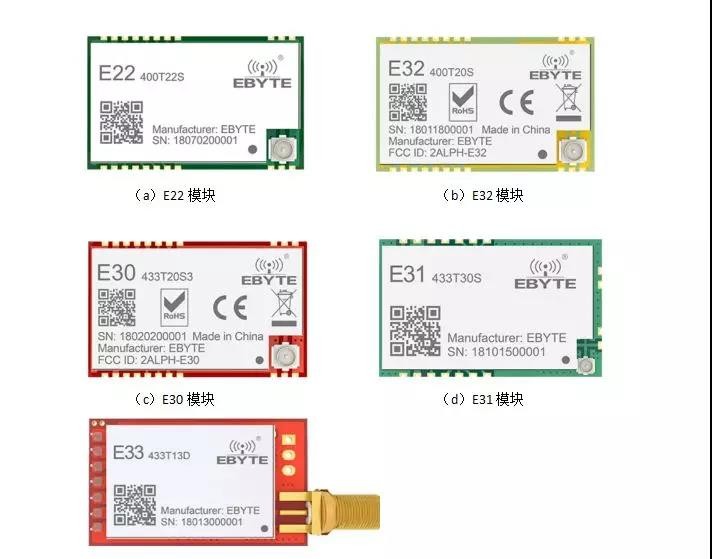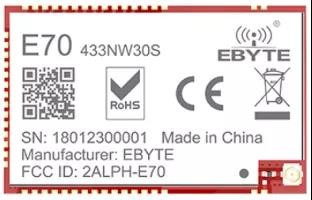

Wireless Serial Module
The wireless serial port module is a module that communicates serial port data through wireless signals. Generally consists of a radio frequency chip and an MCU (some SOC chips have integrated these two parts together). The wireless serial port module has the characteristics of simple operation and is widely used in wireless data acquisition, wireless meter reading, robot control, access control systems, security systems and other fields. Users only need to understand simple serial communication, and they can easily learn complex wireless communication Realize the development and use of wireless products.
Serial Port Module Model
Ebest Electronic Technology Co., Ltd. focuses on the development and research of wireless modules. The types of wireless serial port modules include E22, E32, E30, E31, and E33, providing customers with a wide range of choices. Users can choose the most Suitable wireless serial port module. The following figure is the physical picture of each wireless serial port module:

All the above modules can be configured with baud rate, air speed, module address, frequency channel and other information by the user's host computer provided on the official website, providing users with more flexible operation methods.
Star Networking Module
1. Star network module model
Working in the 433MHz frequency band; the module integrates the host (coordinator) and the terminal into one, with two transmission modes of long distance and high speed. One host (coordinator) supports up to 200 nodes to communicate with it. The instructions greatly simplify user operations and are applicable to multiple wireless communication networking scenarios.
2. Features
E70-433NW30S is the first 433MHz wireless module in China that can support 200 nodes concurrently, which solves a series of problems caused by traditional 433MHz wireless data transmission cannot be concurrent. After concurrency, users no longer need to spend energy on processing complex networking protocols, which greatly reduces the development difficulty of customers and shortens the development cycle of users; its protocol guarantees the stability and packet rate of the entire wireless communication system.
E70-433NW30S module physical map:

Star Networking
In a star topology, each node in the network is connected to a central node in a point-to-point manner, and the central node transmits information to the destination node.
1. For any two nodes in the star network to communicate, they must be controlled by a central node. Therefore, the main functions of the central node are three:
(1) After a communication request is sent from a station that requires communication, the controller checks whether the central node has an idle path and whether the called device is idle, so as to determine whether the physical connection between the two parties can be established;
(2) This channel should be maintained during the communication between the two devices to ensure the reliability of data transmission;
(3) When communication is completed or unsuccessful requires disconnection, the central transfer station shall be able to dismantle the above channels.
Compared with a ring network, the failure of a star network will cause the entire network to be paralyzed and it is more difficult to locate branch node faults. The star network is convenient for centralized control because the communication between terminal nodes must go through the center node. Because of this feature, it also brings advantages such as easy maintenance and safety. When the end node equipment is down due to a failure, it will not affect the communication between other end users. The network delay time is small, and the reliability of the system is high.
2.The main advantages of star topology are:
(1) Easy management and maintenance. Since all data communication passes through the central node, the central node can collect all communication conditions.
(2) Node expansion, simple structure, and convenient movement. Compared with other network topologies, star topology management and maintenance are easy. When a node is expanded, it is only necessary to establish a connection with the central node device, and it will not “take the whole world” like a ring network.
(3) Easy fault diagnosis and isolation. Because each terminal sub-node is connected to the central node, it is convenient to test each node from the central node, and it is also convenient to separate the faulty node from the system.
Because the star network has the above advantages, it has become one of the most widely used network topology designs in the networking mode, but how to avoid communication conflicts among multiple nodes in the star network becomes the most important problem.
Star Networking Methods
In the star topology, in order to effectively avoid communication conflicts between the nodes, the central node and the terminal node interact mainly in the following two common ways, one is the active polling method, and the other is the passive time slice method.
1.Active polling method
In the active polling method, each terminal node has its own unique ID number, and the central node actively asks the terminal node in turn whether there is data to be sent according to the terminal node ID number. If a terminal node has data to send to the central node, then The central node starts processing the received data.
Advantages:
(1) Terminal nodes are not restricted by time slices and are more free;
(2) When the terminal node and the central node interact infrequently, there is theoretically no requirement for the length and time of the transmitted data;
(3) The network stability is high. The passive time slice method has high requirements on the crystal consistency of each node, and the active polling method will not affect the communication of each node due to the small deviation of the crystal;
(4) The program structure is more simple and clear than the passive time slice method, and easy to understand;
Disadvantages
(1) If a terminal node sends data continuously, it will directly affect the communication between other terminal nodes and the central node, and may cause other terminal nodes to fail to communicate with the central node normally.
(2) Since the terminal node does not have the function of actively sending data, it must send the data only after being inquired by the central node. Therefore, terminal nodes that have not been polled cannot immediately send data even if they have data.
(3) If there are more terminal nodes in the network, the more time it takes for the central node to poll the terminal nodes once, the greater the network delay.
2.Passive time slice method
Passive time slice means that the central node will periodically synchronize the time of all terminal nodes in the network. A terminal node wants to send data only within its own time slice and cannot be longer than the time allocated by the system. It is necessary to ensure that tasks are executed To be able to enter the task to be executed,
Advantages:
(1) The communication efficiency of the passive time slice method is higher, which saves the time required for the central node to poll in the active polling method. Since the active polling method requires the central node to sequentially query whether the terminal node has data to send according to the ID number of the terminal node in order to ensure that the data of each node will not conflict and ensure the reliability of the network, the query process is There is no valid data for interaction. From the perspective of data transmission, the query time is "invalid".
(2) The time slice of each terminal node can be set, which is more flexible;
(3) Due to the time slice mechanism, each terminal node is independent of each other, making data interaction more orderly;
Disadvantages:
(1) When writing a program, the time slice needs to be reasonably set, and the time for each terminal node to interact with the central node is relatively strict. If the time slice is set too short, it will cause too many interrupts and task switching, which will reduce the CPU efficiency. If the time slice is set too long, it may cause poor response to the terminal node interactive request;
(2) The central node must send synchronization commands regularly to avoid the situation where the time of each node is not synchronized due to the deviation of the crystal oscillator between the terminal nodes. If the central node does not send the synchronization command, it may cause time slice confusion, data transmission errors and even It's a network crash.
(3) The data of each terminal node can only be sent in its own time slice. If the data is not sent within the specified time slice, it can only wait until the next time to continue sending.
In general, the active polling method is suitable for occasions with low real-time requirements and a large amount of data transmission each time, and the passive time slice method is more suitable for occasions with high real-time requirements and small data transmission volumes.